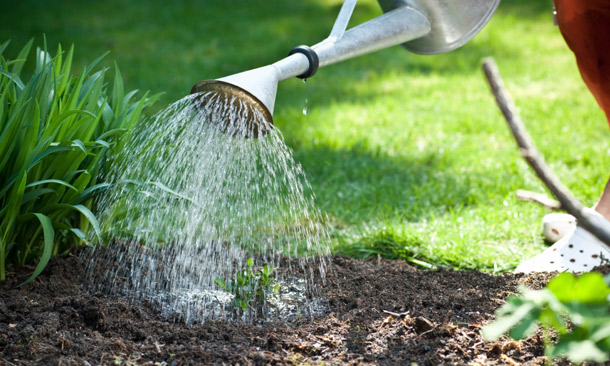 Understanding your soil type is the first step to effective watering. Soil types can be broken into three basic categories, loam, clay and sand.
Understanding your soil type is the first step to effective watering. Soil types can be broken into three basic categories, loam, clay and sand.
Loam soil – Loam is the ideal soil type, it holds water and drains well and can be watered deeply and infrequently.
Clay soil – Clay soil holds moisture for long periods however if allowed to dry out can become hard and hydrophobic and water can just run off. It can be improved by tilling with organic matter and by adding gypsum. Water deeply and slowly so that water can soak through.
Sandy soil – Sandy soils should be watered frequently in smaller volumes as water tends to drain away and soil will dry out again quickly.
This diagram shows how water is distributed in different soil types:
Building a loamy soil by adding compost and organic matter, breaking up clay with gypsum and adding coco-peat to sandy soils will make a huge difference to your garden’s water needs.
Great elements for building soil are cocopeat, compost, green manure, composted animal manure, straw and worm castings.
As discussed in an earlier article Mulch, mulch, mulch – mulch can potentially reduce your water requirements by up to 60%. Cover beds with 75mm of composted pine mulch or 40mm of pea or cane mulch for vegetable beds.
At the end of the day, the plants in your garden will dictate how much you need to water. Good garden design and understanding the cultural needs of your plants will allow you to make decisions about when and how much water needs to be added.
One you know your soil type and your plants requirements, you water accordingly. If you are hose watering, you can test the flow rate by measuring the time it takes to fill a 10L bucket, which will give you a good idea, of how much water you are applying. Add water directly to the root zone.
Rather than frequent, surface watering, deep watering through the root zone encourages deep root development. In the long run, encouraging deep root development circumvents the need for regular supplementary watering – do this for juvenile trees, shrubs and perennials to establish strong root development and cut down on water consumption in the future. Plants with naturally shallow or fibrous root balls such as Camellia’s will always need frequent, regular watering as well as a good layer of leaf mold and mulch to keep the root ball cool and moist. Pot plants, annuals and vegetables will need frequent, regular watering.
Installing irrigation systems cuts out the labour and along with developing your soil can provide a customized supplementary water program that will allow your garden to flourish.


